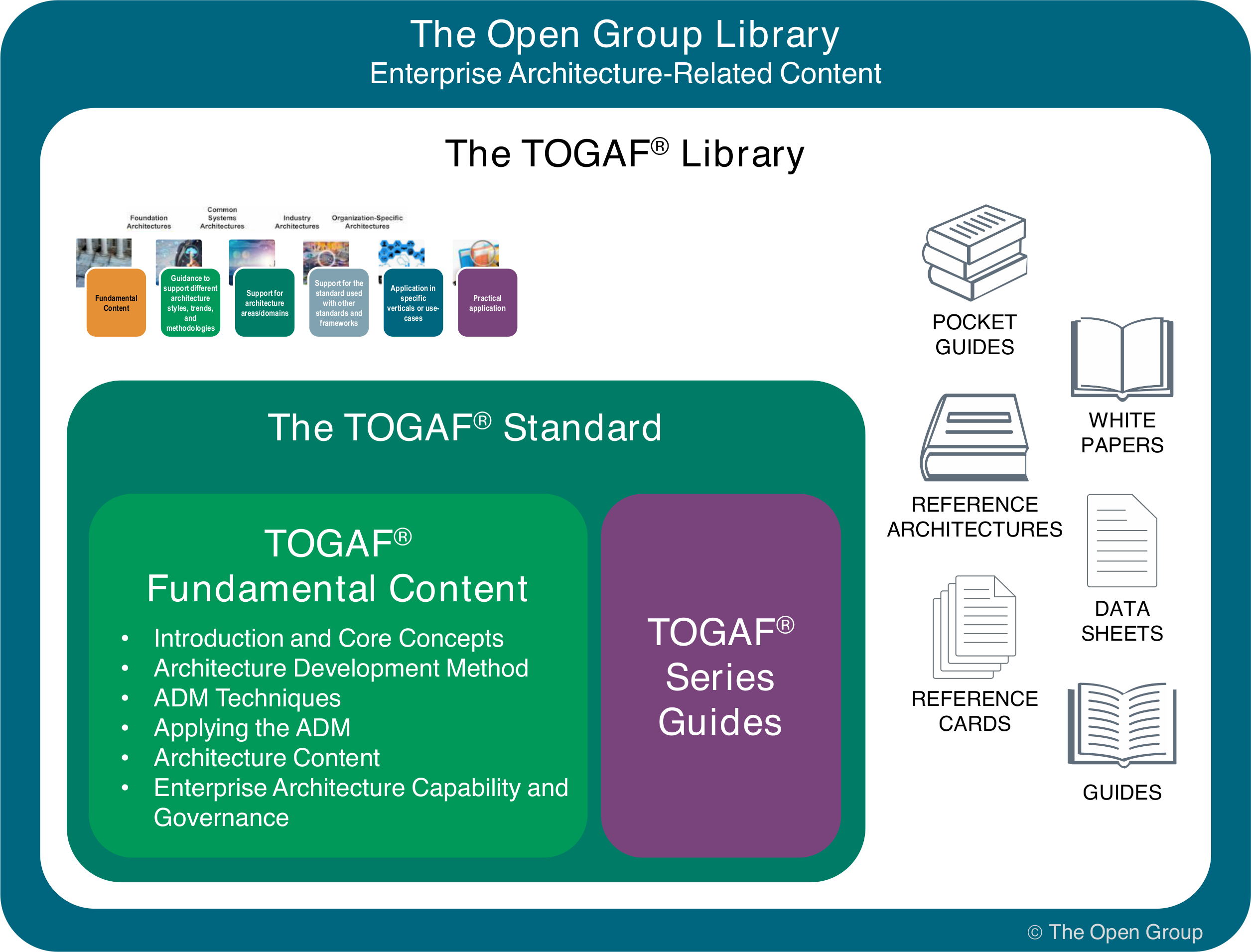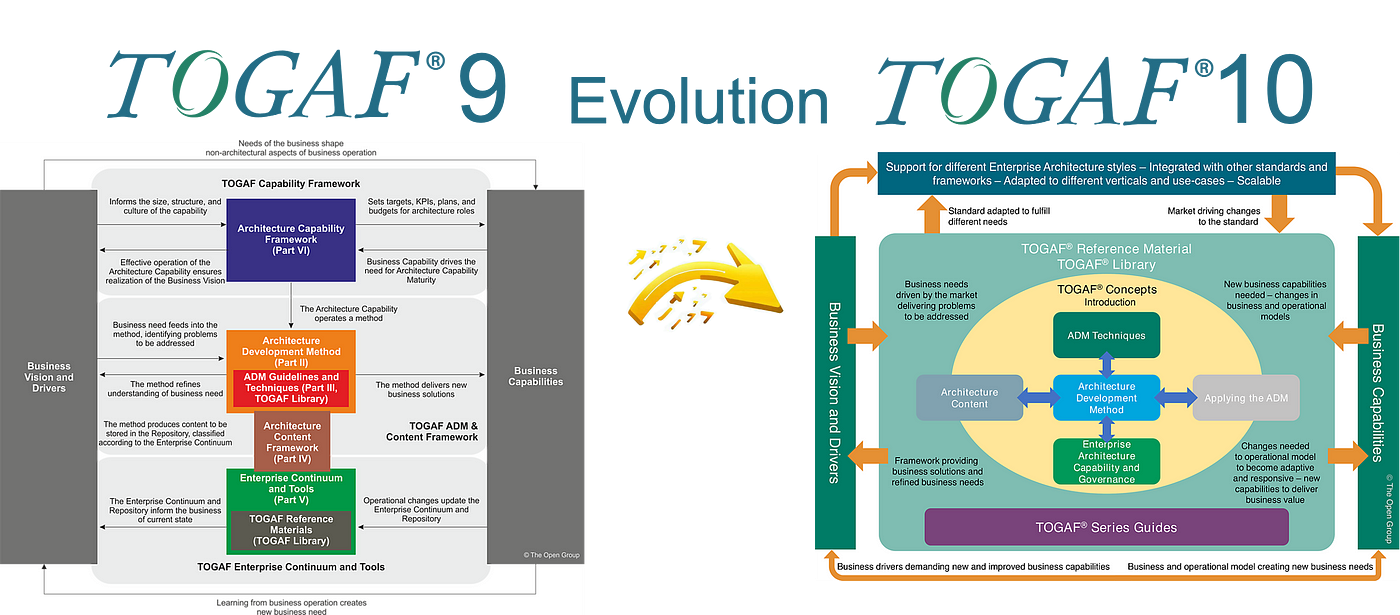TOGAF - The Open Group Architecture Framework
TOGAF, or The Open Group Architecture Framework, is a blueprint that guides businesses in aligning their objectives with their enterprise software development architecture. It’s like a roadmap for efficiently creating and managing IT infrastructures that support the overarching goals of a business.

What is TOGAF?
- Definition: TOGAF is a methodology that provides a structured approach for developing enterprise software. It aims to minimize errors, adhere to timelines, stick to budget constraints, and ensure IT projects are in sync with business operations to deliver high-quality outcomes.
- History: Since its inception by The Open Group in 1995, TOGAF has become widely adopted. As of 2016, 80% of Global 50 and 60% of Fortune 500 companies have utilized TOGAF. It is free for internal use within organizations but requires a fee for commercial use.
- Certification and Courses: Organizations can certify their tools, software, or training programs through The Open Group. Presently, there are eight TOGAF-certified tools and 71 accredited courses offered by 70 entities.
- TOGAF Standard, 10th Edition: In 2022, The Open Group introduced the TOGAF Standard, 10th Edition, as a more accessible and updated version, replacing the 9.2 Edition. This latest edition focuses on efficiency and provides enhanced guidance for applying the TOGAF framework.
Overview of the TOGAF Framework
TOGAF serves as a foundation for IT management, helping businesses to:
- Synchronize IT objectives with business goals.
- Coordinate IT efforts across different departments.
- Define and organize project requirements from the outset, promoting rapid progress with minimal errors.
The TOGAF framework consists of two main components:
- Fundamental Content: This includes core principles and best practices.
- Extended Guidance: This offers detailed guidance on specific areas such as agile methodologies, business architecture, and security architecture.
The framework is designed to evolve, with the extended guidance expected to grow with new best practices, while the fundamental content provides a solid starting point for framework application.
According to The Open Group, TOGAF aims to:
- Harmonize the language used across the board.
- Avoid dependence on proprietary solutions by advocating for open methods.
- Save time and money and improve resource utilization.
- Yield measurable ROI.
- Offer a comprehensive view of an organization’s architecture.
- Act as a flexible, scalable framework for business transformation.
- Serve as a uniform standard for enterprise architecture across industries of all sizes.
Business Advantages of TOGAF
TOGAF enables structured and organized implementation of software technology, emphasizing governance and business objectives. It facilitates collaboration across various departments and ensures that key stakeholders are aligned. By establishing a common language between IT and business teams, TOGAF clarifies roles and expectations throughout the development process.
Organizations can adapt TOGAF to their needs, starting with the core fundamentals and then selecting relevant parts from the extended guidance to create a tailored framework.
What’s New in TOGAF 10?

The latest changes in TOGAF include:
- A new modular structure for easier application, especially in agile environments.
- Streamlined documentation, with redundant or outdated content removed.
- A design that’s simpler to update, allowing for ongoing improvements without disrupting established best practices.
Modules in TOGAF 10 cover various topics, including:
- Core concepts and ADM (Architecture Development Method).
- ADM techniques and application.
- Content for architectural framework.
- Governance and enterprise architecture capabilities.
The extended guidance delves into areas such as security, business, and data architectures, along with agile methods.
TOGAF Certification and Training
The TOGAF 9.2 certification comprises two levels:
- Level 1: Covers TOGAF 9.1 foundations.
- Level 2: Focuses on the practical application of TOGAF, including relevant technology and tools.
Certifications are valid indefinitely and recognized globally, making them valuable for enterprise architects and other IT professionals.
While information on TOGAF 10 certification isn’t available yet, the existing TOGAF 9.2 certification can significantly increase salary prospects for various IT roles.
Salaries with TOGAF certification may look like this:
| Job Title | Average Salary | With TOGAF Certification |
|---|---|---|
| IT Enterprise Architect | $137,188 | $144,831 |
| Solutions Architect | $121,579 | $140,648 |
| IT Architect | $120,772 | $139,759 |
| Software Architect | $128,451 | $134,876 |
| IT Director | $122,363 | $153,459 |
Training for TOGAF certification is available through various platforms, offering both online and in-person options.
The Open Group maintains a list of certified TOGAF tools to assist with enterprise architecture and digital transformation.
The Evolution of TOGAF
Originating from the TAFIM framework of the US Department of Defense, TO```markdown TOGAF stands as a pivotal enterprise architecture framework, streamlining the alignment of business objectives with the architectural goals in software development realms.
Explaining TOGAF
TOGAF, or The Open Group Architecture Framework, embodies a methodology for enterprise-level software development. It provides a high-level blueprint to effectively orchestrate the development lifecycle, targeting error reduction, adherence to timelines and budgets, and syncing IT with business functions for superior outcomes.
- Origins: Birthed by The Open Group in 1995, TOGAF’s adoption rates by 2016 reached 80% among the Global 50 and 60% for Fortune 500 companies.
- Usage: Free for internal use; the framework is licensable for commercial applications.
- Certifications and Learning: As of the latest data, the framework boasts eight certified tools and 71 accredited courses from 70 institutions.
- TOGAF Standard, 10th Edition: A 2022 release offering streamlined integration within businesses and more accessible best practices for organizational application.
TOGAF Framework at a Glance
TOGAF bridges IT and business goals, while ensuring inter-departmental IT efforts are cohesive. The framework is bifurcated into:
- Core Content: The bedrock principles and practices of TOGAF.
- Extended Guidance: Detailed advice on agile approaches, business and data architecture, security, and more.
TOGAF is dynamic, with its extended guidance designed to incorporate emerging best practices, while the core content remains the foundation for framework adoption.
Key intentions of TOGAF include:
- Standardizing language to avoid miscommunication.
- Dodging proprietary solution lock-in by promoting open methods.
- Optimizing time, cost, and resource use.
- Providing measurable return on investment.
- Giving a bird’s-eye view of organizational architecture.
- Serving as a scalable, versatile framework for transformative efforts.
- Offering a universal standard for enterprise architecture across all sectors.
TOGAF’s Commercial Edge
TOGAF equips organizations with a methodical approach to software technology deployment, focusing on governance and strategic business goals. It enhances multi-departmental collaboration, streamlines stakeholder communication, and fosters a common understanding between IT and business entities.
With TOGAF’s modular design, especially in its 10th edition, organizations can customize the framework to their specific needs, starting with core elements and selectively integrating extended guidance as required.
Innovations in TOGAF 10
The TOGAF 10th Edition introduces:
- A modular format for ease of use in agile settings.
- Refined documentation, excising superfluous or obsolete material.
- A more flexible updating mechanism to seamlessly integrate new best practices.
The fundamental modules encompass:
- Introduction and core concepts
- Architecture development method (ADM) and techniques
- ADM applications
- Architecture content framework
- Capability and governance in enterprise architecture
While extended guidance covers:
- Enterprise architecture team setup
- Security, business, and data architectures
- Agile methodologies
- Reference models and methods
Certification and Learning Pathways for TOGAF
TOGAF 9.2 certification encompasses:
- Level 1: Understanding TOGAF 9.1 foundations.
- Level 2: Practical knowledge of TOGAF, related technologies, tools, and concepts.
The certification is perpetual and has worldwide recognition, adding value to the professional profiles of enterprise architects.
Salary increases associated with TOGAF certification are evident across various IT roles:
| Job Title | Average Salary | With TOGAF Certification |
|---|---|---|
| IT Enterprise Architect | $137,188 | $144,831 |
| Solutions Architect | $121,579 | $140,648 |
| IT Architect | $120,772 | $139,759 |
| Software Architect | $128,451 | $134,876 |
| IT Director | $122,363 | $153,459 |
For TOGAF certification preparation, there are multiple avenues, including online and physical classroom settings.
Additionally, The Open Group lists TOGAF certified tools that support enterprise architecture endeavors.
Tracing TOGAF’s Roots
TOGAF has evolved from the TAFIM model, initially crafted by the US Department of Defense. Since its release in 1995, TOGAF has undergone several iterations, culminating in the comprehensive TOGAF 10 in 2022. At its core, the ADM remains the linchpin of TOGAF, guiding the enterprise architecture lifecycle and enabling customization to fulfill specific organizational requirements.